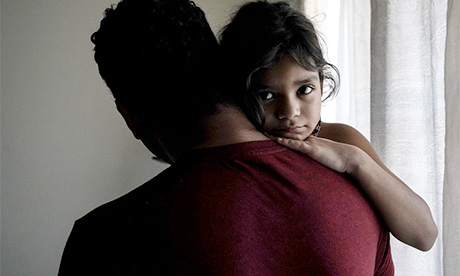Carlos had been thinking about migrating to the U.S. since he was a kid.
In San Francisco de la Paz, a valley outpost ringed by lush hills in the lawless “Wild East” of Honduras, about the only business that’s booming is home construction — fueled by American dollars sent home each month from migrants living in the U.S. Remittances from former villagers helped Carlos scratch out a living, but with every dab of mortar he splashed on vacant homes, he longed to join their owners.
Making $13 a day as a construction worker, he could barely afford to take care of his wife and daughter, let alone help his parents buy medicine for a range of ailments including diabetes, high blood pressure and thyroid disease.
Plus, the street violence that has ravaged Honduras hit too close to home a few years ago, when a cousin was murdered by suspected drug traffickers.
So last year, Carlos, 25, did what most Hondurans do when it’s time to get out: He approached one of the three local smugglers who operate in rural San Francisco de la Paz, which has a population of about 20,000.
The smuggler gave him a price: $7,000 to cross the Rio Grande and seek asylum — but only if he took his little girl and they surrendered to the U.S. Border Patrol on the other side.
Otherwise it would cost $10,000 to traverse Mexico and then evade a gantlet of law enforcement at the border and the interior checkpoints beyond.
Carlos’ wife, Claudia, pushed back.
She feared sending their only daughter, Heyli, who was 6 at the time, on a nearly 1,700-mile journey in uncertain conditions.
She’d heard grisly stories of migrants suffocating in 18-wheelers or getting assaulted on the long trek through Mexico.
Why couldn’t Carlos go by himself?
“I told [the smuggler] many times, ‘Better alone,’” Claudia recalls.
“But he said, ‘No, it will be easier, better with the girl.’”
And cheaper.
The decision was wrenching.
Leaving would break up their tiny family and require them to go deep into debt.
But Carlos and Claudia always dreamed of an easier life for Heyli, away from the grinding poverty of Honduras. So the deal was struck.
Thousands of Central Americans are making the same calculation every month.
The money that desperate people are willing to scrape together to come to the U.S. has turned humans into cash cows.
Despite the Trump Administration’s “zero-tolerance” policy designed to deter illegal border crossing, the apprehension of “family units” on the U.S.-Mexico border has skyrocketed to record levels in recent months, according to the Border Patrol.
In the past five months, Border Patrol agents were apprehending family units at a rate 338 percent higher than in the same period a year earlier.
Unlike the attention-grabbing caravans that have been making their way to Tijuana, the movements of migrants who hire smugglers — and most migrants do — are not tracked by media outlets or in President Donald Trump’s Twitter feed.
Like Carlos and Heyli, they slip through Mexico with smugglers, known as coyotes, who bribe cartels and corrupt cops and immigration agents along the way. (Carlos is a pseudonym; the rest of his family members are referred to in this story by their real first names.)
The money that desperate people are willing to scrape together to come to the U.S. has turned humans into cash cows.
According to a 2018 U.N. report, the migrant-smuggling industry was worth $5.7 billion to $7 billion worldwide in 2016.
Since the U.S. remains the top destination for migrants, the North American market is the crown jewel of the global smuggling trade. Continue reading
- Image: Verónica G. Cárdenas for The Texas Tribune/TIME
- This story is part of a collaboration between TIME and The Texas Tribune to track the family separation crisis at the U.S.-Mexico border.
To watch a documentary about Carlos and Heyli’s journey through the migrant-smuggling industry, watch it here.
Additional reading
News category: Analysis and Comment.




